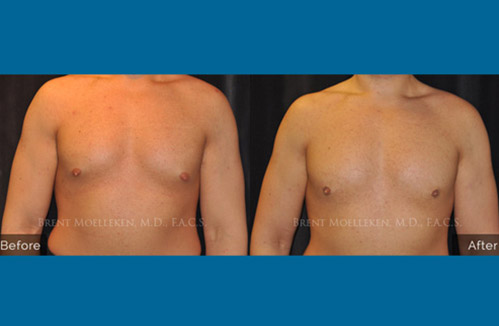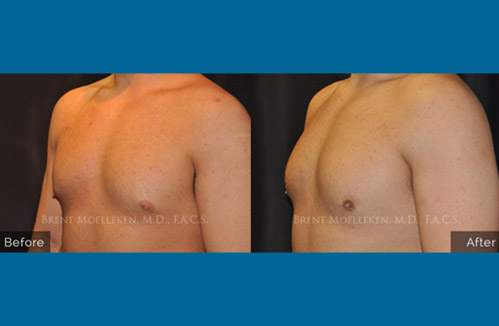Gynecomastia Reduction


What Is Gynecomastia?
Gynecomastia is a condition of over-developed breasts in men in which the breast tissue enlarges. The condition may occur in one or both breasts and starts as a small lump beneath the nipple. Although usually benign, the breast often grows unevenly. Many patients will find little to no changes with diet and exercise alone. Gynecomastia reduction can surgically reshape the chest to a more masculine contour.
Reduction Benefits
A square, chiseled chest is the sign of a man who is fit and confident. Unfortunately, it may seem like only a dream for men living with Gynecomastia. This condition affects almost half of the male population. Thankfully, Dr. Brent performs the surgery for men who want to tighten and tone their chests. Dr. Brent has seen remarkable increases in self-confidence in his male patients.
Table of Contents
Overview of Gynecomastia Reduction
At a Glance
Your gynecomastia surgery will be an outpatient procedure. The operation takes approximately 1 hour. Individual factors may increase the length of the surgery. Dr. Brent will use either general or local anesthesia to sedate you.
The Procedure Elements
- Incisions: Dr. Brent will make an incision in an inconspicuous location. He chooses either on the edge of the dark skin around your nipple or in your underarm area. Through the incision, he will cut away the excess glandular tissue, fat, and skin from around your areola and from the sides and bottom of your breast. In a reduction of higher amounts of excess tissue, larger incisions may be necessary, resulting in more noticeable scars.
- Fat Removal: If Dr. Brent has determined you have excessive fatty tissue, he will consider liposuction/liposculpture. This procedure is a more appropriate surgical technique for the removal of this tissue. At the edge of your areola or in your underarm area, he will make a tiny incision, less than a half-inch in length, and insert the cannula. Dr. Brent will move the cannula through the layers beneath your skin, breaking up the fat and suctioning it out.
- Excess Skin Removal: Removal of excess skin will be adjusted to fit your new breast contour. Dr. Brent tightens the remaining skin to form a natural-looking contour over the chest.
- Additional Elements: Occasionally, a small drain will go in through a separate incision to relieve excess fluids. Upon completion, Dr. Brent and his team will cover your incision and wrap you with an elastic bandage. The elastic bandage will hold your skin firmly in place.
FAQs
What causes gynecomastia?
In some cases, the cause may be unknown. The condition can also occur due to fluctuations in hormonal changes. The changes in hormones include an increase in estrogen or a decrease in testosterone. Among older men, it also consists of an increase in body fat. There are dozens of known contributing factors to the development of this condition.
Some of these include:
- Obesity
- Alcohol, marijuana, or steroid misuse
- Thyroid disease
- Testosterone deficiency or testicular hormone production irregularities
- Liver or kidney failure
- Chronic kidney disease
- Tumors in the testicles, stomach, or pituitary gland
- Congenital syndromes present at birth
- Natural aging
- Some prescription medications and medications containing estrogen
- Use of herbal testosterone additives
- Klinefelter syndrome
- Gilbert syndrome
- Puberty
Who is a candidate for Gynecomastia Surgery?
You may be a candidate for Gynecomastia Surgery if you:
- Are in good overall health
- Currently are at a healthy, stable weight
- Feel that your breasts are too large
- Have a reasonable understanding of the surgery results
Teens benefit from Gynecomastia reduction as well if their condition has been present for more than 2 years or if the problem is severe. In some teens, secondary procedures may occur later if breast development continues.
Do I have gynecomastia or chest fat?
Breast glandular tissue will feel notably different from fat. Fat typically has a soft feel to it, while glandular tissue will feel more solid. If you are only experiencing weight gain in the chest, it may be gynecomastia. Still, a professional diagnosis is the only sure way to determine what your situation is. While chest fat can go away with exercise, glandular tissue may not resolve naturally.
What should I expect during the consultation?
Your initial consultation with Dr. Brent requires your complete medical history. You should prepare and provide the necessary information. Dr. Brent will examine your chest area. A breast X-ray may determine how much fat and glandular tissue is present in both breasts. This information will help Dr. Brent plan the best procedure for your needs. The consultation is also an opportunity for you to ask questions and express any concerns. Dr. Brent will give you specific instructions on what to do before your procedure. Instructions include:
- Adhering to a healthy diet with proper nutritional intake
- Taking specific vitamins and medications
- Not smoking, as smoking decreases circulation and impedes healing
You must follow all provided guidelines to promote a safe experience.
What are the types of gynecomastia reduction?
During your consultation, Dr. Brent will discuss different procedures with you. He will help you choose the procedure to provide the best optimal outcome for your situation. The options include:
Pseudogynecomastia
The removal of the fatty tissue by suction using a negative pressure source (pump or syringe). This technique is usually performed with the tumescent method to decrease bleeding.
True Gynecomastia
The removal of tissue by surgical excision, usually performed through the lower part of your areola and the skin. The procedure will typically leave inconspicuous scars.
Combined Pseudogynecomastia and True Gynecomastia
Combination of surgical excision and liposuction for better breast contour.
Periareolar Gynecomastia Reduction
Periareolar (incision around your nipple-areola complex) Gynecomastia reduction:
- The procedure is for mild to moderate reductions.
- Classical reduction with superior or inferior flaps: For more massive breasts (C, D), leaves an inverted xTx incision and Periareolar incision.
- Vertical incision: vertical subareolar scar (not horizontal scar) in large breasts.
What are the different techniques used?
The techniques depend upon the quality and quantity of your excess tissue and skin. The two methods commonly used in Gynecomastia surgery are suction lipectomy and endoscopic surgery.
Lipectomy creates tapered breast tissue, resulting in a natural look. Endoscopic surgery is a small, flexible tube with a light, and the camera gets inserted in your chest by tiny incisions. In some cases, liposculpture helps remove the fibrous fat and breast tissue that develops in the male chest. If the breast tissue is too dense and firm, occasionally, a small incision hidden around the areola is necessary to remove it. When the skin is very loose and thin and will not likely tighten up after tissue removal, an excisional skin procedure may be required.
In severe cases of Gynecomastia, the weight of excess breast tissue may cause your breasts to sag and stretch the areola. In these cases, the position and size of the areola can be surgically improved, with excess skin reduced.
What is the recovery like after Gynecomastia Surgery?
You should arrange to be driven home after your surgery and have someone help you manage for a day or two if necessary. It is normal to feel some discomfort or pain for a few days after your procedure. Prescribed medication can reduce the pain, but some patients manage with even over-the-counter pain relievers. Bruising and swelling may occur.
You will have to wear an elastic pressure garment around the clock for at least 2 weeks, then at night for several weeks until you heal. Any extreme swelling will resolve in the first few weeks, but it may be 3 months or longer before your recovery is complete.
What does downtime involve?
Recovery is built on a foundation of downtime. While you are waiting for your results, you will need to take time away from work and certain activities. Downtime gives your body the time and rest it needs to heal properly. As tempting as it might be, do not rush your downtime. Your results will look much better if you give yourself the allotted time to heal.
After the surgery, your downtime should consist of:
- Taking about 2 weeks off from work
- No sexual activity for approximately 2 weeks
- Strenuous exercise for 2 weeks
- Avoiding any action or job that risks a blow to your chest area for at least a month
- Preventing sun exposure for your scars for at least 6 months (sunlight will darken your scars permanently)
When will I see the results?
Gynecomastia reduction surgery can dramatically improve your appearance. It is essential to remember that individual results are unpredictable, but working with a skilled surgeon can produce consistent benefits. The results of the procedure are significant, and Dr. Brent’s patients are satisfied with their improved physique.
Your initial results should be visible about 2 weeks after surgery. Your swelling should mostly resolve by this point, allowing you to see your chest’s new shape. Full results can take somewhat longer but will not be dramatically different from initial results. As residual swelling goes down, your chest tissues can settle into their final positions.
Can male breasts come back?
The biggest worry many patients have is about breasts forming again following their procedure. Generally, patients should not experience any recurrence of male breasts. The glandular tissue is entirely removed and should not grow back. However, tissue fluctuations can still happen. Before surgery, we inform patients about each of these factors so they can take steps to avoid them.
- Medication: The use of certain medications can contribute to continued breast enlargement.
- Weight Gain: Significant weight gain can lead to a range of physical changes, including in the chest area.
Can I combine with other procedures?
Many patients who have gynecomastia may benefit from combining it with another surgery. Dr. Brent offers several other body procedures that can tone, sculpt, and define the upper body. His approach to each of these procedures focuses on maintaining a masculine aesthetic. This involves removing fat and resectioning tissue to highlight muscle definition. Popular combined procedures include:
- Male tummy tuck (abdominoplasty)
- Body lift
- Arm lift
How much does gynecomastia reduction cost?
The final cost for Gynecomastia surgery can vary. It will depend on the techniques used and the complexity of the procedure. Additional factors include anesthesia type and combined procedures. While the cost can vary, the surgery with the right surgeon can prove a lifetime investment.
Dr. Brent provides each patient with an individual quote based on their consultation. Each quote transparently shows the cost elements. Always feel free to ask any questions at any point.
Are there nonsurgical options for Gynecomastia reduction?
Surgery delivers the most consistent and sculpted results for addressing gynecomastia. Nonsurgical solutions tend to lean toward lifestyle changes, such as pausing medications, losing weight, or improving diet. However, these may not prove effective once the breast tissue has already developed. At your consultation, Dr. Brent will go over your case and make personalized recommendations. If you have had persistent gynecomastia for 1 or more years, surgery may be needed.
How should I choose my gynecomastia surgeon?
Gynecomastia Surgery is a complex procedure requiring an in-depth understanding of the masculine physique. Start by looking for a board-certified plastic surgeon. Then, choose someone who has years of experience, showcasing successful procedures with before-and-after photos. See what their real patients look like. Lastly, set up your consultation to meet with the surgeon. Take your time to discuss your situation with them and see how you feel. The right surgeon combines skill, experience, results, and a welcoming atmosphere for an all-around positive patient experience.
Gynecomastia Reduction in Los Angeles
Dr. Brent is a double board-certified plastic surgeon in Beverly Hills. He is one of the most highly skilled surgeons for gynecomastia in the country and has received his training at Harvard, Yale, and UCLA. Due to his commitment to patient outcomes, he has been selected as one of Vogue Magazine’s “Top 10 Plastic Surgeons in America.” Contact Dr. Brent today for a consultation exploring your Gynecomastia surgery options.


